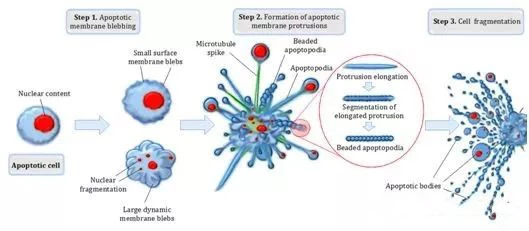The study found that cell death spreads by trigger waves

The study found that cell death spreads by trigger waves

Copyright © iCell Bioscience Inc, Shanghai 2018-2019
Two hands swinging upwards will produce one after another sound waves until the infrasound waves travel far away in the stadium. This rolling surge is motivated by the activity of one or several events and is therefore referred to as a trigger wave. The trigger wave requires two main factors: a positive feedback loop and a threshold.
It has been previously discovered that in the cell cycle, cells divide to produce new cells, and trigger waves can regulate the production of new cells. The same is true for neuronal action potentials, which allows neurons to propagate signals through electrical impulses.
In a new study, Ferrell and postdoctoral researcher Dr. Xianrui Cheng found that in apoptosis, cell death also spreads through trigger waves. Once cell death begins (whether disease or otherwise), the specific killer protein in the cell, the protease caspase, which is called the cysteine-containing aspartate proteolytic enzyme, is activated. These proteins then come into contact with other caspase by floating and activate them; these other caspases follow suit until the entire cell dies.

It spreads in this way, never slows down, never disappears. There is no reduction in its amplitude because in each step of generating its own power, it converts more inactive molecules into active molecules until apoptosis spreads to every corner and crack in the cell.
To observe the effects of death on individual cells, the researchers used the eggs of the African clawed frog. When cells undergo apoptosis, the eggs of the Xenopus frog have larger sizes, which makes them the main candidates for visually observing how death spreads from one end of the cell to the other.
The liquid is first extracted from the egg and added to a few millimeters long Teflon tube and apoptosis is initiated by the molecular "death signal". By using a fluorescent technique associated with activation of apoptosis, the two researchers observed that when bright green fluorescence moves down at a constant rate, this indicates that apoptosis is propagated through the trigger wave rather than through other Some more basic mechanisms (such as diffusion) spread.
Observation with a fluorescence microscope is very difficult because the intact Xenopus frog eggs are very opaque. However, the researchers noted that when the Xenopus frog egg died, a ripple of pigmentation occurred on the surface of the egg.
The researchers found that during the death, a black corrug passed through the egg at a constant speed from side to side like a curve. The velocity of this surface wave is constant and there is no deceleration, ie this also forms a trigger wave. Therefore, in order to further confirm this, a single dead egg was analyzed, and each egg that had experienced such a surface wave contained an activated protease caspase, and an egg that had not experienced such a surface wave did not. In summary, there is more evidence that trigger waves also transmit cell death signals in intact cells. So far, apoptosis has been the only form of cell death that has been identified by trigger waves.
Researchers are investigating whether trigger waves may determine how our innate immune response travels between cells. The virus spreads between cells by trigger waves, so there is reason to believe that the same strategy can be used for the initial immune defense line.
 Loading ....
Loading ....
